Making a Difference: Social Work Framework for Trauma in Australia
VerifiedAdded on 2022/11/11
|7
|2065
|109
Report
AI Summary
This report presents a social work framework designed to address the issue of domestic violence and child abuse, specifically within the Australian context. The framework emphasizes a trauma-informed approach, advocating for a shift from asking "what is wrong with you" to "what happened to you." It highlights the prevalence of domestic violence in Australia, particularly among women and indigenous populations, and identifies gaps in current social services that often focus on physical violence while overlooking psychological trauma. The framework emphasizes the importance of understanding the cultural backgrounds of victims, implementing strength-based approaches, and incorporating principles such as trustworthiness, choice, safety, and collaboration. The report also identifies key social work skills, including mindfulness, cultural understanding, and reflection. Furthermore, it outlines strategies for building relationships with clients and offers recommendations for future development, including increased funding for research and collaboration to improve the effectiveness of trauma-informed care practices.
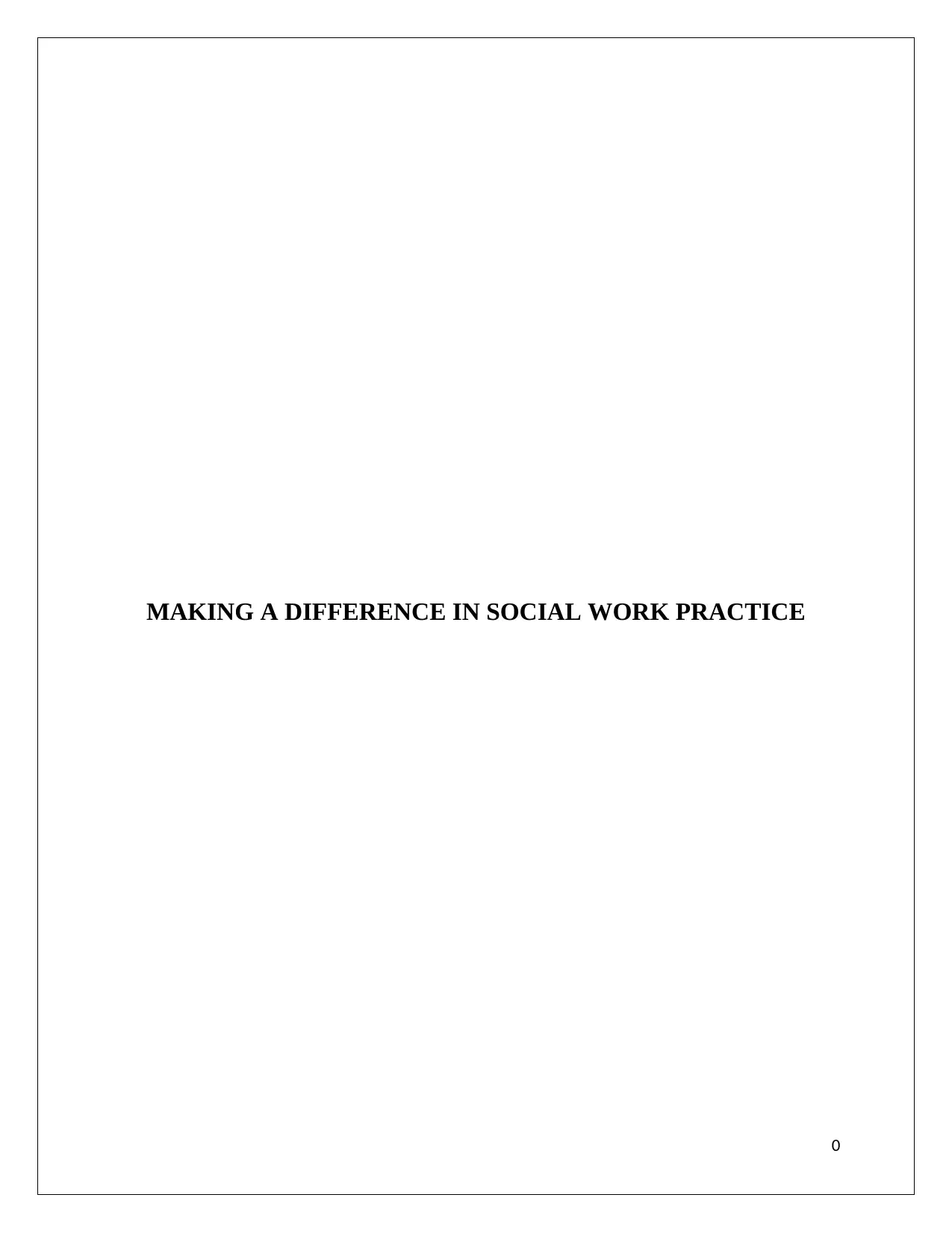
MAKING A DIFFERENCE IN SOCIAL WORK PRACTICE
0
0
Paraphrase This Document
Need a fresh take? Get an instant paraphrase of this document with our AI Paraphraser
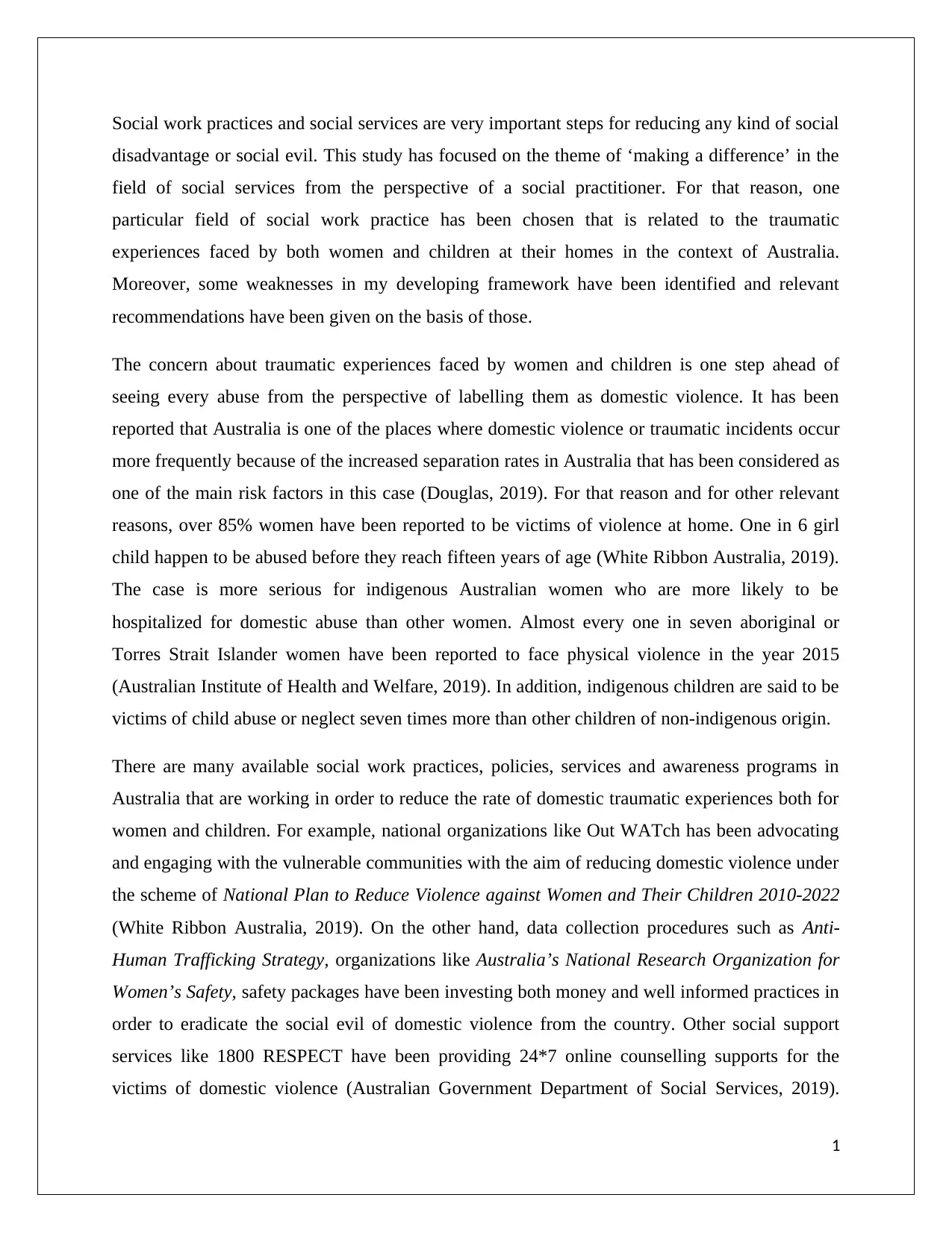
Social work practices and social services are very important steps for reducing any kind of social
disadvantage or social evil. This study has focused on the theme of ‘making a difference’ in the
field of social services from the perspective of a social practitioner. For that reason, one
particular field of social work practice has been chosen that is related to the traumatic
experiences faced by both women and children at their homes in the context of Australia.
Moreover, some weaknesses in my developing framework have been identified and relevant
recommendations have been given on the basis of those.
The concern about traumatic experiences faced by women and children is one step ahead of
seeing every abuse from the perspective of labelling them as domestic violence. It has been
reported that Australia is one of the places where domestic violence or traumatic incidents occur
more frequently because of the increased separation rates in Australia that has been considered as
one of the main risk factors in this case (Douglas, 2019). For that reason and for other relevant
reasons, over 85% women have been reported to be victims of violence at home. One in 6 girl
child happen to be abused before they reach fifteen years of age (White Ribbon Australia, 2019).
The case is more serious for indigenous Australian women who are more likely to be
hospitalized for domestic abuse than other women. Almost every one in seven aboriginal or
Torres Strait Islander women have been reported to face physical violence in the year 2015
(Australian Institute of Health and Welfare, 2019). In addition, indigenous children are said to be
victims of child abuse or neglect seven times more than other children of non-indigenous origin.
There are many available social work practices, policies, services and awareness programs in
Australia that are working in order to reduce the rate of domestic traumatic experiences both for
women and children. For example, national organizations like Out WATch has been advocating
and engaging with the vulnerable communities with the aim of reducing domestic violence under
the scheme of National Plan to Reduce Violence against Women and Their Children 2010-2022
(White Ribbon Australia, 2019). On the other hand, data collection procedures such as Anti-
Human Trafficking Strategy, organizations like Australia’s National Research Organization for
Women’s Safety, safety packages have been investing both money and well informed practices in
order to eradicate the social evil of domestic violence from the country. Other social support
services like 1800 RESPECT have been providing 24*7 online counselling supports for the
victims of domestic violence (Australian Government Department of Social Services, 2019).
1
disadvantage or social evil. This study has focused on the theme of ‘making a difference’ in the
field of social services from the perspective of a social practitioner. For that reason, one
particular field of social work practice has been chosen that is related to the traumatic
experiences faced by both women and children at their homes in the context of Australia.
Moreover, some weaknesses in my developing framework have been identified and relevant
recommendations have been given on the basis of those.
The concern about traumatic experiences faced by women and children is one step ahead of
seeing every abuse from the perspective of labelling them as domestic violence. It has been
reported that Australia is one of the places where domestic violence or traumatic incidents occur
more frequently because of the increased separation rates in Australia that has been considered as
one of the main risk factors in this case (Douglas, 2019). For that reason and for other relevant
reasons, over 85% women have been reported to be victims of violence at home. One in 6 girl
child happen to be abused before they reach fifteen years of age (White Ribbon Australia, 2019).
The case is more serious for indigenous Australian women who are more likely to be
hospitalized for domestic abuse than other women. Almost every one in seven aboriginal or
Torres Strait Islander women have been reported to face physical violence in the year 2015
(Australian Institute of Health and Welfare, 2019). In addition, indigenous children are said to be
victims of child abuse or neglect seven times more than other children of non-indigenous origin.
There are many available social work practices, policies, services and awareness programs in
Australia that are working in order to reduce the rate of domestic traumatic experiences both for
women and children. For example, national organizations like Out WATch has been advocating
and engaging with the vulnerable communities with the aim of reducing domestic violence under
the scheme of National Plan to Reduce Violence against Women and Their Children 2010-2022
(White Ribbon Australia, 2019). On the other hand, data collection procedures such as Anti-
Human Trafficking Strategy, organizations like Australia’s National Research Organization for
Women’s Safety, safety packages have been investing both money and well informed practices in
order to eradicate the social evil of domestic violence from the country. Other social support
services like 1800 RESPECT have been providing 24*7 online counselling supports for the
victims of domestic violence (Australian Government Department of Social Services, 2019).
1
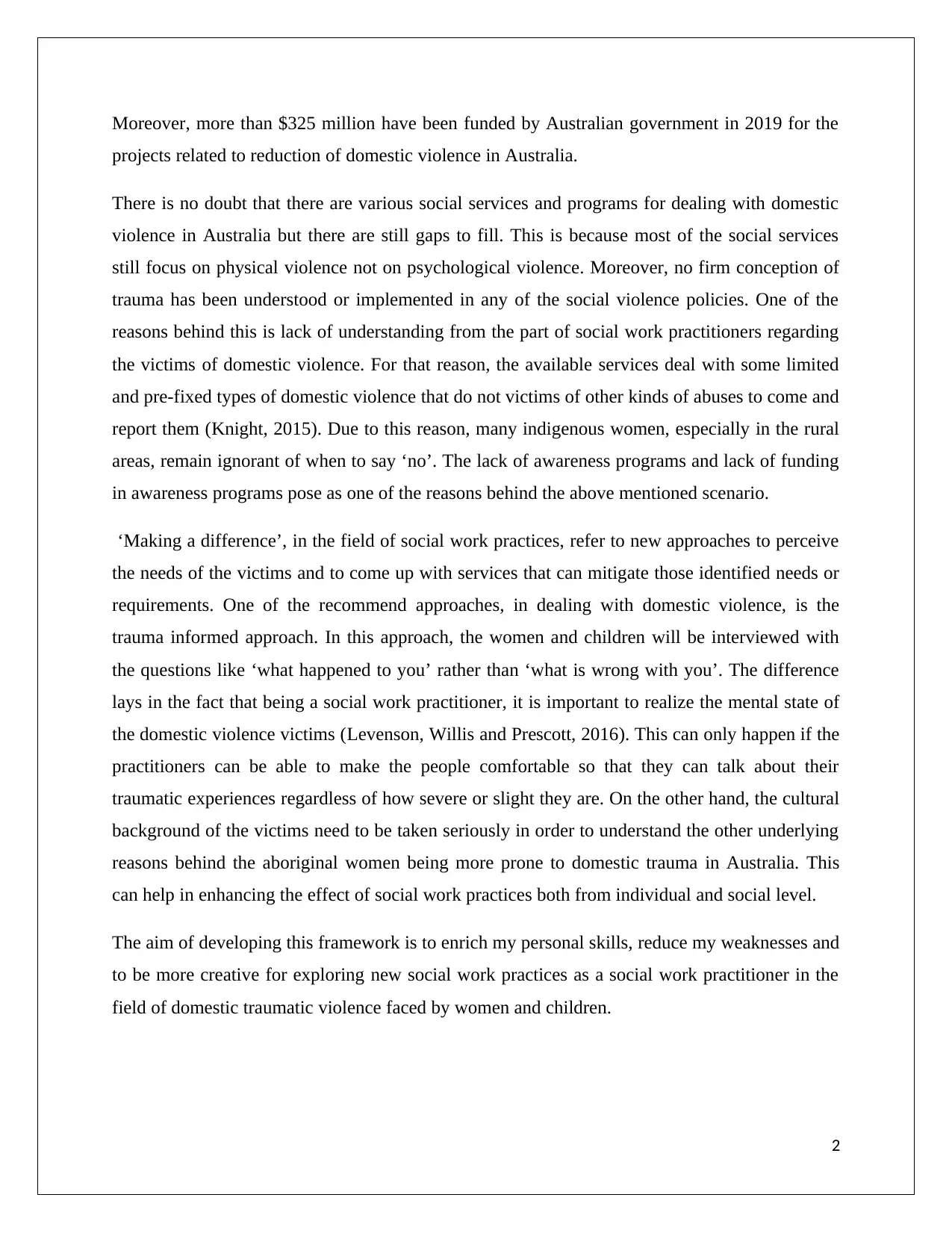
Moreover, more than $325 million have been funded by Australian government in 2019 for the
projects related to reduction of domestic violence in Australia.
There is no doubt that there are various social services and programs for dealing with domestic
violence in Australia but there are still gaps to fill. This is because most of the social services
still focus on physical violence not on psychological violence. Moreover, no firm conception of
trauma has been understood or implemented in any of the social violence policies. One of the
reasons behind this is lack of understanding from the part of social work practitioners regarding
the victims of domestic violence. For that reason, the available services deal with some limited
and pre-fixed types of domestic violence that do not victims of other kinds of abuses to come and
report them (Knight, 2015). Due to this reason, many indigenous women, especially in the rural
areas, remain ignorant of when to say ‘no’. The lack of awareness programs and lack of funding
in awareness programs pose as one of the reasons behind the above mentioned scenario.
‘Making a difference’, in the field of social work practices, refer to new approaches to perceive
the needs of the victims and to come up with services that can mitigate those identified needs or
requirements. One of the recommend approaches, in dealing with domestic violence, is the
trauma informed approach. In this approach, the women and children will be interviewed with
the questions like ‘what happened to you’ rather than ‘what is wrong with you’. The difference
lays in the fact that being a social work practitioner, it is important to realize the mental state of
the domestic violence victims (Levenson, Willis and Prescott, 2016). This can only happen if the
practitioners can be able to make the people comfortable so that they can talk about their
traumatic experiences regardless of how severe or slight they are. On the other hand, the cultural
background of the victims need to be taken seriously in order to understand the other underlying
reasons behind the aboriginal women being more prone to domestic trauma in Australia. This
can help in enhancing the effect of social work practices both from individual and social level.
The aim of developing this framework is to enrich my personal skills, reduce my weaknesses and
to be more creative for exploring new social work practices as a social work practitioner in the
field of domestic traumatic violence faced by women and children.
2
projects related to reduction of domestic violence in Australia.
There is no doubt that there are various social services and programs for dealing with domestic
violence in Australia but there are still gaps to fill. This is because most of the social services
still focus on physical violence not on psychological violence. Moreover, no firm conception of
trauma has been understood or implemented in any of the social violence policies. One of the
reasons behind this is lack of understanding from the part of social work practitioners regarding
the victims of domestic violence. For that reason, the available services deal with some limited
and pre-fixed types of domestic violence that do not victims of other kinds of abuses to come and
report them (Knight, 2015). Due to this reason, many indigenous women, especially in the rural
areas, remain ignorant of when to say ‘no’. The lack of awareness programs and lack of funding
in awareness programs pose as one of the reasons behind the above mentioned scenario.
‘Making a difference’, in the field of social work practices, refer to new approaches to perceive
the needs of the victims and to come up with services that can mitigate those identified needs or
requirements. One of the recommend approaches, in dealing with domestic violence, is the
trauma informed approach. In this approach, the women and children will be interviewed with
the questions like ‘what happened to you’ rather than ‘what is wrong with you’. The difference
lays in the fact that being a social work practitioner, it is important to realize the mental state of
the domestic violence victims (Levenson, Willis and Prescott, 2016). This can only happen if the
practitioners can be able to make the people comfortable so that they can talk about their
traumatic experiences regardless of how severe or slight they are. On the other hand, the cultural
background of the victims need to be taken seriously in order to understand the other underlying
reasons behind the aboriginal women being more prone to domestic trauma in Australia. This
can help in enhancing the effect of social work practices both from individual and social level.
The aim of developing this framework is to enrich my personal skills, reduce my weaknesses and
to be more creative for exploring new social work practices as a social work practitioner in the
field of domestic traumatic violence faced by women and children.
2
⊘ This is a preview!⊘
Do you want full access?
Subscribe today to unlock all pages.

Trusted by 1+ million students worldwide
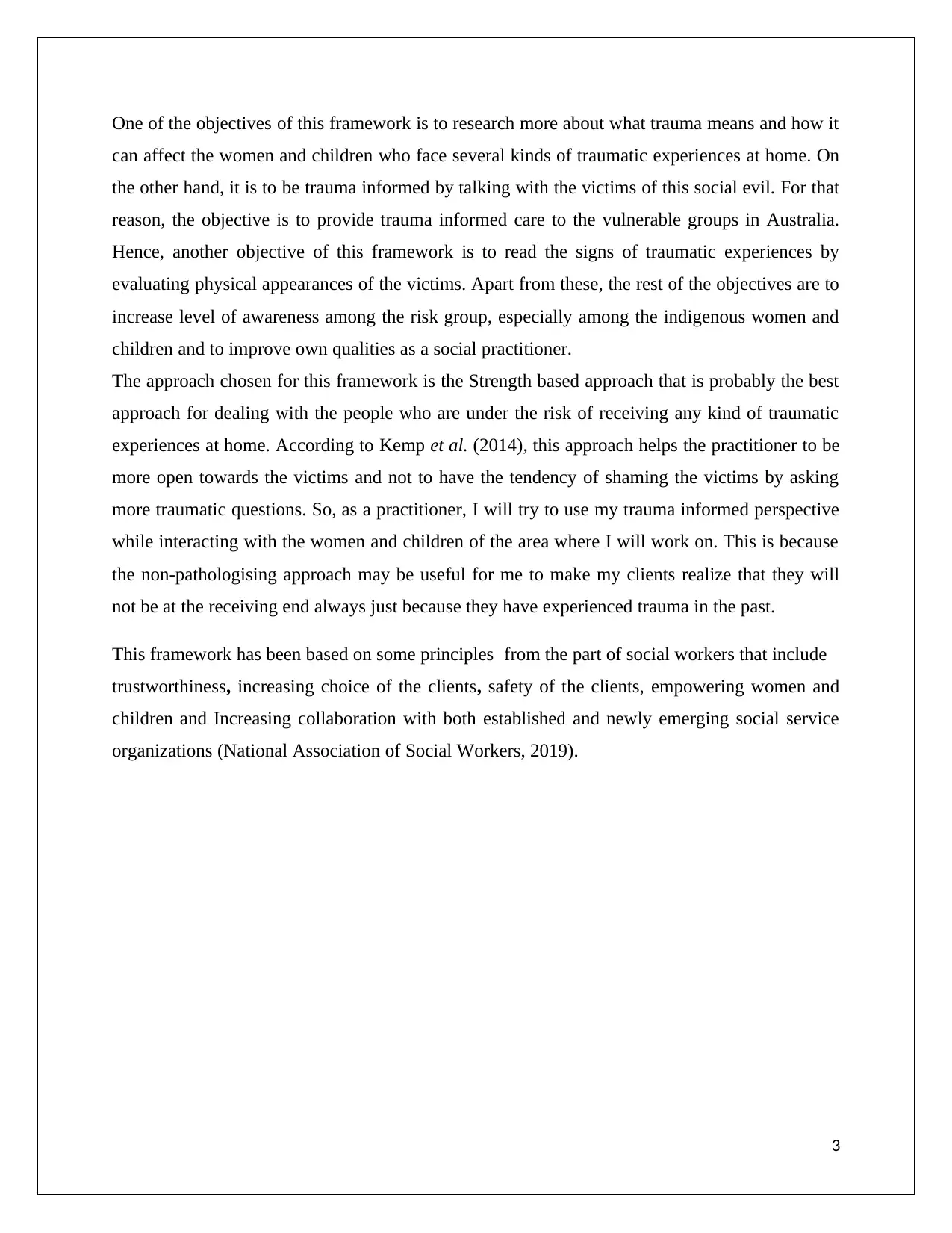
One of the objectives of this framework is to research more about what trauma means and how it
can affect the women and children who face several kinds of traumatic experiences at home. On
the other hand, it is to be trauma informed by talking with the victims of this social evil. For that
reason, the objective is to provide trauma informed care to the vulnerable groups in Australia.
Hence, another objective of this framework is to read the signs of traumatic experiences by
evaluating physical appearances of the victims. Apart from these, the rest of the objectives are to
increase level of awareness among the risk group, especially among the indigenous women and
children and to improve own qualities as a social practitioner.
The approach chosen for this framework is the Strength based approach that is probably the best
approach for dealing with the people who are under the risk of receiving any kind of traumatic
experiences at home. According to Kemp et al. (2014), this approach helps the practitioner to be
more open towards the victims and not to have the tendency of shaming the victims by asking
more traumatic questions. So, as a practitioner, I will try to use my trauma informed perspective
while interacting with the women and children of the area where I will work on. This is because
the non-pathologising approach may be useful for me to make my clients realize that they will
not be at the receiving end always just because they have experienced trauma in the past.
This framework has been based on some principles from the part of social workers that include
trustworthiness, increasing choice of the clients, safety of the clients, empowering women and
children and Increasing collaboration with both established and newly emerging social service
organizations (National Association of Social Workers, 2019).
3
can affect the women and children who face several kinds of traumatic experiences at home. On
the other hand, it is to be trauma informed by talking with the victims of this social evil. For that
reason, the objective is to provide trauma informed care to the vulnerable groups in Australia.
Hence, another objective of this framework is to read the signs of traumatic experiences by
evaluating physical appearances of the victims. Apart from these, the rest of the objectives are to
increase level of awareness among the risk group, especially among the indigenous women and
children and to improve own qualities as a social practitioner.
The approach chosen for this framework is the Strength based approach that is probably the best
approach for dealing with the people who are under the risk of receiving any kind of traumatic
experiences at home. According to Kemp et al. (2014), this approach helps the practitioner to be
more open towards the victims and not to have the tendency of shaming the victims by asking
more traumatic questions. So, as a practitioner, I will try to use my trauma informed perspective
while interacting with the women and children of the area where I will work on. This is because
the non-pathologising approach may be useful for me to make my clients realize that they will
not be at the receiving end always just because they have experienced trauma in the past.
This framework has been based on some principles from the part of social workers that include
trustworthiness, increasing choice of the clients, safety of the clients, empowering women and
children and Increasing collaboration with both established and newly emerging social service
organizations (National Association of Social Workers, 2019).
3
Paraphrase This Document
Need a fresh take? Get an instant paraphrase of this document with our AI Paraphraser
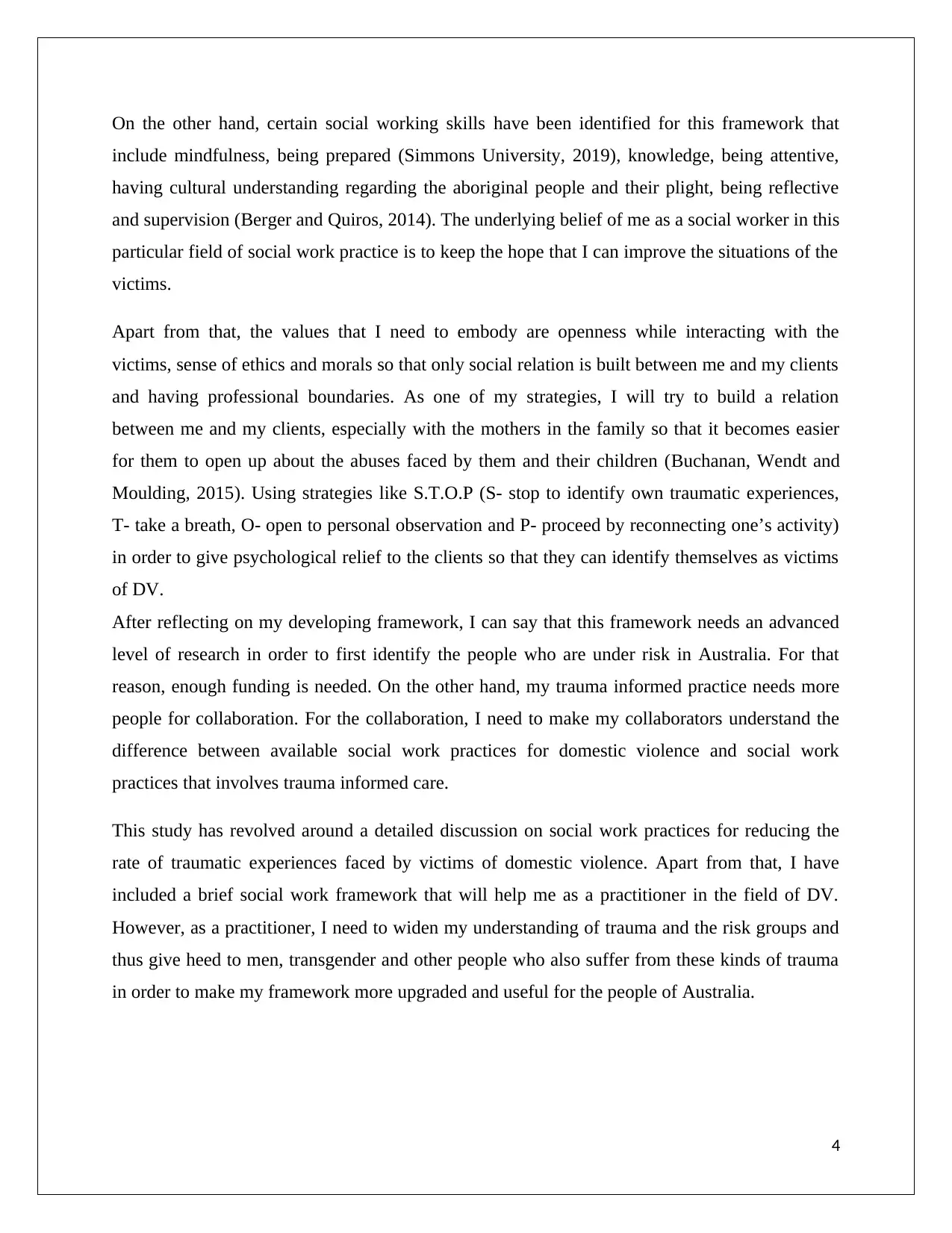
On the other hand, certain social working skills have been identified for this framework that
include mindfulness, being prepared (Simmons University, 2019), knowledge, being attentive,
having cultural understanding regarding the aboriginal people and their plight, being reflective
and supervision (Berger and Quiros, 2014). The underlying belief of me as a social worker in this
particular field of social work practice is to keep the hope that I can improve the situations of the
victims.
Apart from that, the values that I need to embody are openness while interacting with the
victims, sense of ethics and morals so that only social relation is built between me and my clients
and having professional boundaries. As one of my strategies, I will try to build a relation
between me and my clients, especially with the mothers in the family so that it becomes easier
for them to open up about the abuses faced by them and their children (Buchanan, Wendt and
Moulding, 2015). Using strategies like S.T.O.P (S- stop to identify own traumatic experiences,
T- take a breath, O- open to personal observation and P- proceed by reconnecting one’s activity)
in order to give psychological relief to the clients so that they can identify themselves as victims
of DV.
After reflecting on my developing framework, I can say that this framework needs an advanced
level of research in order to first identify the people who are under risk in Australia. For that
reason, enough funding is needed. On the other hand, my trauma informed practice needs more
people for collaboration. For the collaboration, I need to make my collaborators understand the
difference between available social work practices for domestic violence and social work
practices that involves trauma informed care.
This study has revolved around a detailed discussion on social work practices for reducing the
rate of traumatic experiences faced by victims of domestic violence. Apart from that, I have
included a brief social work framework that will help me as a practitioner in the field of DV.
However, as a practitioner, I need to widen my understanding of trauma and the risk groups and
thus give heed to men, transgender and other people who also suffer from these kinds of trauma
in order to make my framework more upgraded and useful for the people of Australia.
4
include mindfulness, being prepared (Simmons University, 2019), knowledge, being attentive,
having cultural understanding regarding the aboriginal people and their plight, being reflective
and supervision (Berger and Quiros, 2014). The underlying belief of me as a social worker in this
particular field of social work practice is to keep the hope that I can improve the situations of the
victims.
Apart from that, the values that I need to embody are openness while interacting with the
victims, sense of ethics and morals so that only social relation is built between me and my clients
and having professional boundaries. As one of my strategies, I will try to build a relation
between me and my clients, especially with the mothers in the family so that it becomes easier
for them to open up about the abuses faced by them and their children (Buchanan, Wendt and
Moulding, 2015). Using strategies like S.T.O.P (S- stop to identify own traumatic experiences,
T- take a breath, O- open to personal observation and P- proceed by reconnecting one’s activity)
in order to give psychological relief to the clients so that they can identify themselves as victims
of DV.
After reflecting on my developing framework, I can say that this framework needs an advanced
level of research in order to first identify the people who are under risk in Australia. For that
reason, enough funding is needed. On the other hand, my trauma informed practice needs more
people for collaboration. For the collaboration, I need to make my collaborators understand the
difference between available social work practices for domestic violence and social work
practices that involves trauma informed care.
This study has revolved around a detailed discussion on social work practices for reducing the
rate of traumatic experiences faced by victims of domestic violence. Apart from that, I have
included a brief social work framework that will help me as a practitioner in the field of DV.
However, as a practitioner, I need to widen my understanding of trauma and the risk groups and
thus give heed to men, transgender and other people who also suffer from these kinds of trauma
in order to make my framework more upgraded and useful for the people of Australia.
4
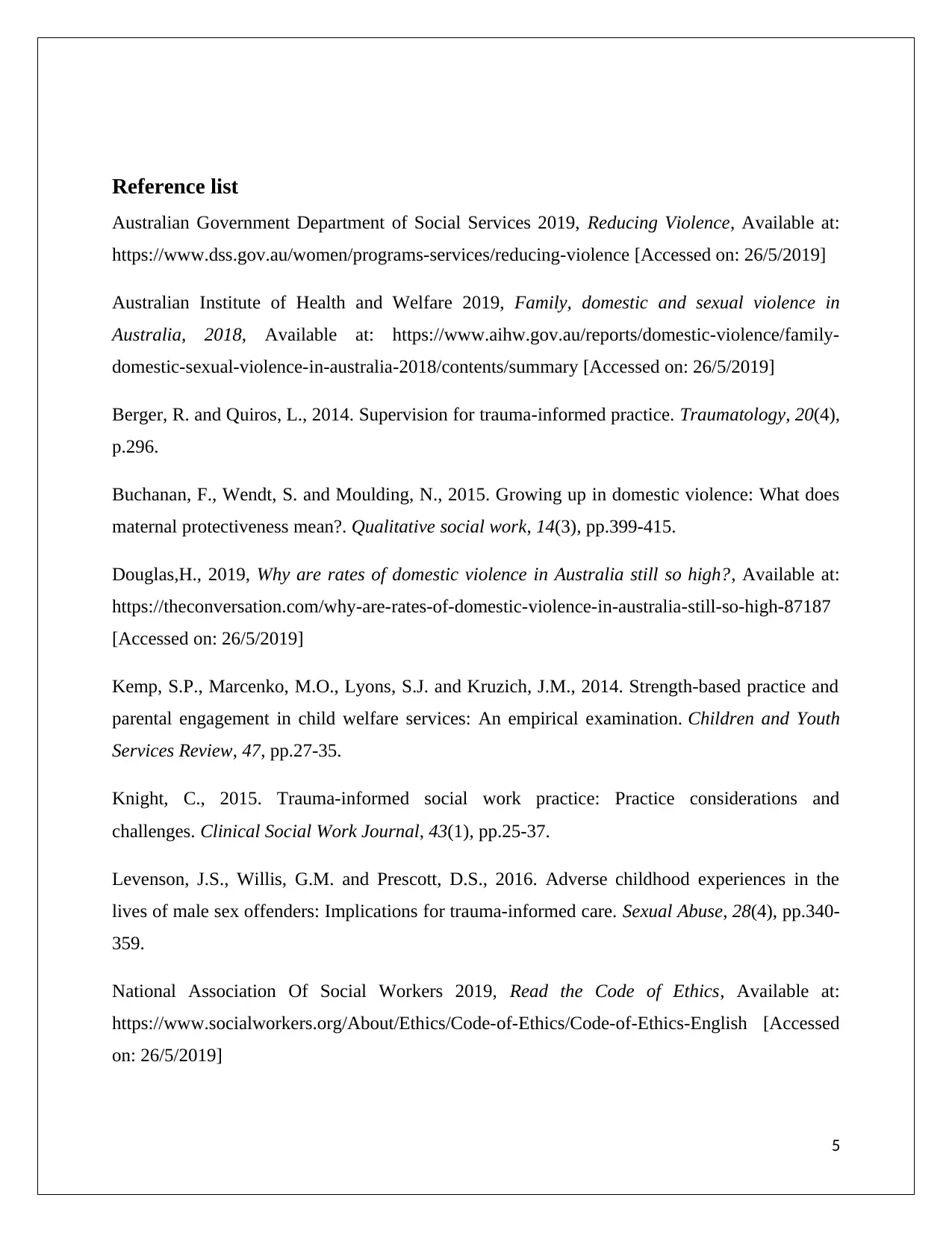
Reference list
Australian Government Department of Social Services 2019, Reducing Violence, Available at:
https://www.dss.gov.au/women/programs-services/reducing-violence [Accessed on: 26/5/2019]
Australian Institute of Health and Welfare 2019, Family, domestic and sexual violence in
Australia, 2018, Available at: https://www.aihw.gov.au/reports/domestic-violence/family-
domestic-sexual-violence-in-australia-2018/contents/summary [Accessed on: 26/5/2019]
Berger, R. and Quiros, L., 2014. Supervision for trauma-informed practice. Traumatology, 20(4),
p.296.
Buchanan, F., Wendt, S. and Moulding, N., 2015. Growing up in domestic violence: What does
maternal protectiveness mean?. Qualitative social work, 14(3), pp.399-415.
Douglas,H., 2019, Why are rates of domestic violence in Australia still so high?, Available at:
https://theconversation.com/why-are-rates-of-domestic-violence-in-australia-still-so-high-87187
[Accessed on: 26/5/2019]
Kemp, S.P., Marcenko, M.O., Lyons, S.J. and Kruzich, J.M., 2014. Strength-based practice and
parental engagement in child welfare services: An empirical examination. Children and Youth
Services Review, 47, pp.27-35.
Knight, C., 2015. Trauma-informed social work practice: Practice considerations and
challenges. Clinical Social Work Journal, 43(1), pp.25-37.
Levenson, J.S., Willis, G.M. and Prescott, D.S., 2016. Adverse childhood experiences in the
lives of male sex offenders: Implications for trauma-informed care. Sexual Abuse, 28(4), pp.340-
359.
National Association Of Social Workers 2019, Read the Code of Ethics, Available at:
https://www.socialworkers.org/About/Ethics/Code-of-Ethics/Code-of-Ethics-English [Accessed
on: 26/5/2019]
5
Australian Government Department of Social Services 2019, Reducing Violence, Available at:
https://www.dss.gov.au/women/programs-services/reducing-violence [Accessed on: 26/5/2019]
Australian Institute of Health and Welfare 2019, Family, domestic and sexual violence in
Australia, 2018, Available at: https://www.aihw.gov.au/reports/domestic-violence/family-
domestic-sexual-violence-in-australia-2018/contents/summary [Accessed on: 26/5/2019]
Berger, R. and Quiros, L., 2014. Supervision for trauma-informed practice. Traumatology, 20(4),
p.296.
Buchanan, F., Wendt, S. and Moulding, N., 2015. Growing up in domestic violence: What does
maternal protectiveness mean?. Qualitative social work, 14(3), pp.399-415.
Douglas,H., 2019, Why are rates of domestic violence in Australia still so high?, Available at:
https://theconversation.com/why-are-rates-of-domestic-violence-in-australia-still-so-high-87187
[Accessed on: 26/5/2019]
Kemp, S.P., Marcenko, M.O., Lyons, S.J. and Kruzich, J.M., 2014. Strength-based practice and
parental engagement in child welfare services: An empirical examination. Children and Youth
Services Review, 47, pp.27-35.
Knight, C., 2015. Trauma-informed social work practice: Practice considerations and
challenges. Clinical Social Work Journal, 43(1), pp.25-37.
Levenson, J.S., Willis, G.M. and Prescott, D.S., 2016. Adverse childhood experiences in the
lives of male sex offenders: Implications for trauma-informed care. Sexual Abuse, 28(4), pp.340-
359.
National Association Of Social Workers 2019, Read the Code of Ethics, Available at:
https://www.socialworkers.org/About/Ethics/Code-of-Ethics/Code-of-Ethics-English [Accessed
on: 26/5/2019]
5
⊘ This is a preview!⊘
Do you want full access?
Subscribe today to unlock all pages.

Trusted by 1+ million students worldwide
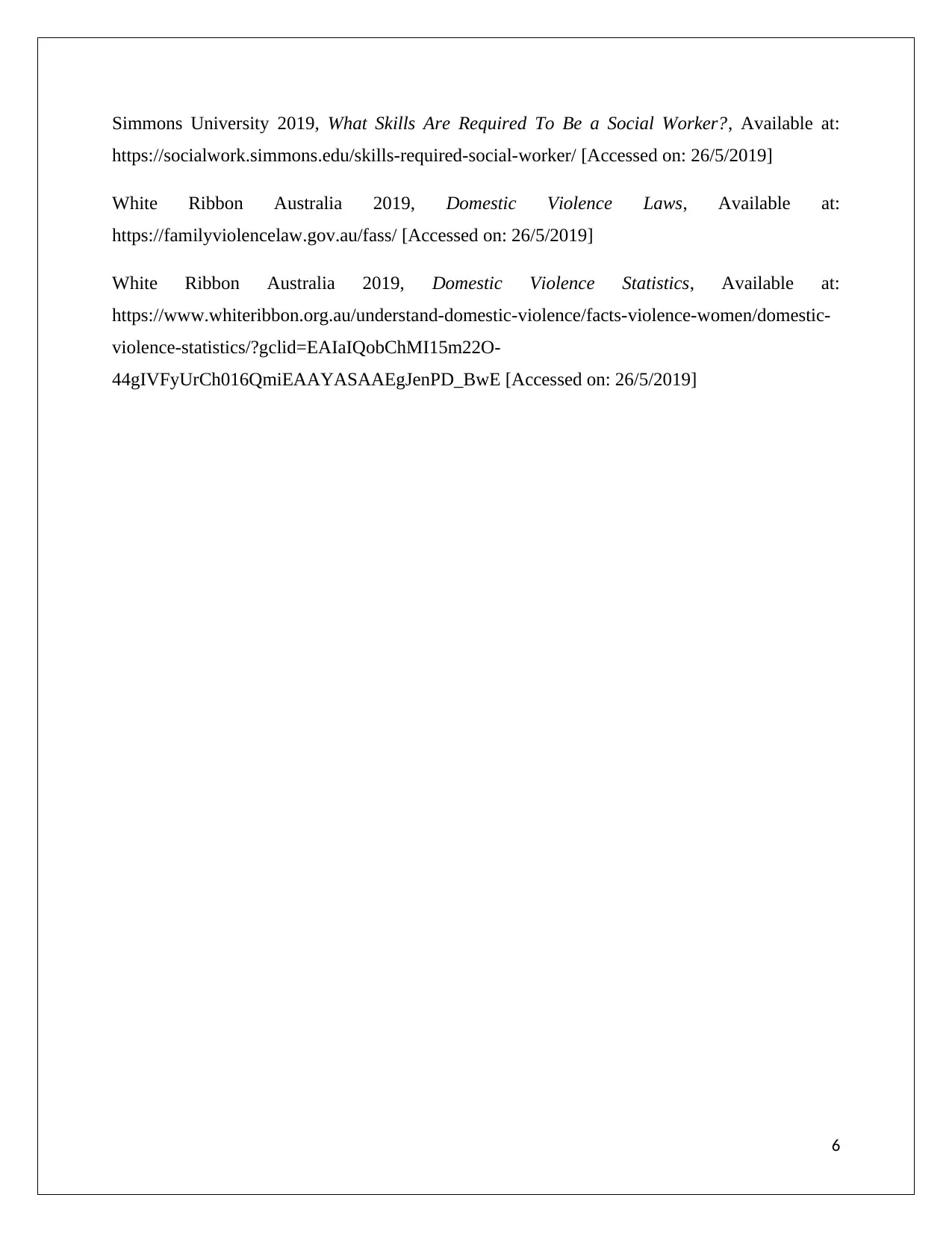
Simmons University 2019, What Skills Are Required To Be a Social Worker?, Available at:
https://socialwork.simmons.edu/skills-required-social-worker/ [Accessed on: 26/5/2019]
White Ribbon Australia 2019, Domestic Violence Laws, Available at:
https://familyviolencelaw.gov.au/fass/ [Accessed on: 26/5/2019]
White Ribbon Australia 2019, Domestic Violence Statistics, Available at:
https://www.whiteribbon.org.au/understand-domestic-violence/facts-violence-women/domestic-
violence-statistics/?gclid=EAIaIQobChMI15m22O-
44gIVFyUrCh016QmiEAAYASAAEgJenPD_BwE [Accessed on: 26/5/2019]
6
https://socialwork.simmons.edu/skills-required-social-worker/ [Accessed on: 26/5/2019]
White Ribbon Australia 2019, Domestic Violence Laws, Available at:
https://familyviolencelaw.gov.au/fass/ [Accessed on: 26/5/2019]
White Ribbon Australia 2019, Domestic Violence Statistics, Available at:
https://www.whiteribbon.org.au/understand-domestic-violence/facts-violence-women/domestic-
violence-statistics/?gclid=EAIaIQobChMI15m22O-
44gIVFyUrCh016QmiEAAYASAAEgJenPD_BwE [Accessed on: 26/5/2019]
6
1 out of 7
Related Documents
Your All-in-One AI-Powered Toolkit for Academic Success.
+13062052269
info@desklib.com
Available 24*7 on WhatsApp / Email
![[object Object]](/_next/static/media/star-bottom.7253800d.svg)
Unlock your academic potential
Copyright © 2020–2025 A2Z Services. All Rights Reserved. Developed and managed by ZUCOL.





